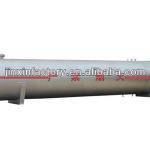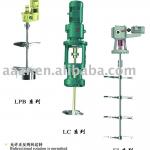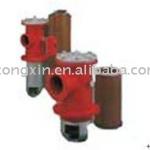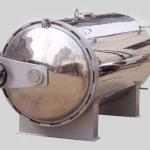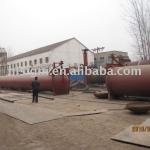Atmospheric Storage Tank
| Condition:New | Place of Origin:Liaoning China (Mainland) | Brand Name:ZL | Model Number:AST |
| Dimension(L*W*H):>500x500x500mm | Capacity:>500L | Weight:>50kg | After-sales Service Provided:Engineers available to service machinery overseas |
| Volume:>500L | Temperature:≤350℃ | Pressure:-0.02Mpa-0.1Mpa | Inside diameter:>500mm |
| Wall thickness:>6mm | DN:>500mm | Certificate:ISO |
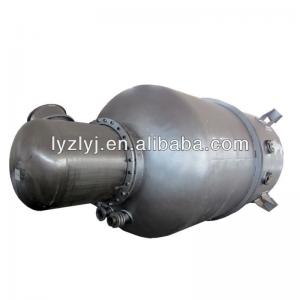
Atmospheric Storage Tank
Liquids are accumulated and stored in tanks of various shapes and sizes throughout the chemical process industries.
A small number of companies have made the design, fabrication and erection of these vessels their specialty. Initially,
however, it is the process engineer who sizes and specifies tanks according to a specific application's needs. In order
to develop a data sheet for tank specifications, it is important for a process engineer to have a basic understanding
of tanks and the related requirements.
Tanks are used to store many kinds of liquids. The focus here is on hydrocarbons, which deserve particular care
because of their flammable or combustible properties. Hydrocarbon liquids can be classified. The National Fire
Protection Association (NFPA) has published several volumes on recommended practices for fire protection,
wherein guidelines pertaining to the storage of hydrocarbon liquids are included.
Tank classifications
According to the NFPA, atmospheric storage tanks are defined as those tanks that are designed to operate at
pressures between atmospheric and 6.9 kPa gage, as measured at the top of the tank. Such tanks are built in
two basic designs--the cone-roof design where the roof remains fixed, and the floating-roof design where the
roof floats on top of the liquid and rises and falls with the liquid level.
Storage tanks are containers that hold liquids, compressed gases (gas tank) or mediums used for the short- or
long-term storage of heat or cold. The term can be used for reservoirs (artificial lakes and ponds), and for
manufactured containers. The usage of the word tank for reservoirs is common or universal in American English
and moderately common in British English. In other countries, the term tends to refer only to artificial containers.
Storage tanks are often cylindrical in shape, perpendicular to the ground with flat bottoms, and a fixed or
floating roof. There are usually many environmental regulations applied to the design and operation of storage
tanks, often depending on the nature of the fluid contained within. Aboveground storage tanks (AST) differ
from underground (UST) storage tanks in the kinds of regulations that are applied.
Reservoirs can be covered, in which case they may be called covered or underground storage tanks or reservoirs.
Covered water tanks are common in urban areas.
Storage tanks are available in many shapes: vertical and horizontal cylindrical; open top and closed top; flat bottom,
cone bottom, slope bottom and dish bottom. Large tanks tend to be vertical cylindrical, or to have rounded corners transition from vertical side wall to bottom profile, to easier withstand hydraulic hydrostatically induced pressure of
contained liquid. Most container tanks for handling liquids during transportation are designed to handle varying
degrees of pressure.
A large storage tank is sometimes mounted on a lorry (truck) or on an articulated lorry trailer, which is then called
a tanker.
Some storage tanks need a floating roof in addition to or in lieu of the fixed roof and structure. This floating roof
rises and falls with the liquid level inside the tank, thereby decreasing the vapor space above the liquid level.
Floating roofs are considered a safety requirement as well as a pollution prevention measure for many industries
including petroleum refining.
Tanks for a particular fluid are chosen according to the flash-point of that substance. Generally in refineries and
especially for liquid fuels, there are fixed roof tanks, and floating roof tanks.
1.Fixed roof tanks are meant for liquids with very high flash points, (e.g. fuel oil, water, bitumen etc.) Cone roofs,
dome roofs and umbrella roofs are usual. These are insulated to prevent the clogging of certain materials, wherein
the heat is provided by steam coils within the tanks. Dome roof tanks are meant for tanks having slightly higher
storage pressure than that of atmosphere (e.g. slop oil).
2.Floating roof tanks are broadly divided into external floating roof tanks (usually called as floating roof tanks:
FR Tanks) and internal floating roof types(IFR Tanks).
IFR tanks are used for liquids with low flash-points(e.g. ATF, MS. gasoline, ethanol). These tanks are nothing but
cone roof tanks with a floating roof inside which travels up and down along with the liquid level. This floating roof
traps the vapor from low flash-point fuels. Floating roofs are supported with legs or cables on which they rest.
FR tanks do not have a fixed roof (it is open in the top) and has a floating roof only. Medium flash point liquids
such as naphtha, kerosene, diesel, crude oil etc. are stored in these tanks.
One of the common types found in mining areas is, open roof type tank, usually to store ore slurries. obviously these
are the easiest storage tanks to be constructed.
Other classification which can be made for storage tanks are based upon their location in a refinery:
COT- crude oil tankages
PIT- product and intermediate storage tankages
DISPATCH- dispatch area tankages
UTILITIES- tanks made in the powerplant area, for storage water etc.
OSBL tanks- the first 3 types come under out side battery limit tankages
ISBL tanks- these are usually mini tanks which are found in the production units of a refinery (as neutralisation
tanks, water tanks etc.)
As flash-points of fuels go very low the tanks are usually spherical (known as spheres), tom store LPG,
hydrogen, hexane, nitrogen, oxygen etc.
Other Types of tank
Atmospheric
An atmospheric tank is a container for holding a liquid at atmospheric pressure. The major design code for welded
atmospheric tanks are API 650 and API 620. API 653 is used for analysis of in-service storage tanks.
High pressure
Horizontal, cylindrical shell, elliptical heads carbon steel pressure vesselMain article: Gas cylinder
In the case of a liquefied gas such as hydrogen or chlorine, or a compressed gas such as compressed natural gas or
MAPP, the storage tank must be made to withstand the sometimes immense pressures exerted by the contents.
These tanks may be called cylinders and, being pressure vessels, are sometimes excluded from the class of "tanks".
Thermal storage tanks[edit]One form of seasonal thermal energy storage (STES) is the use of large surface water
tanks that are insulated and then covered with earth berms to enable the year-round of solar-thermal heat that is
collected primarily in the summer for all-year heating.A related technology has become widespread in Danish district
heating systems. The thermal storage medium is gravel and water in large, shallow, lined pits that are covered with
insulation, soil and grass.Ice and slush tanks are used for short-term of cold for use in air conditioning, allowing
refrigeration equipment to be run at night when electric power is less expensive, yet provide cooling during hot
daytime hours.
Milk tank
Main article: Bulk tank
In dairy farming a bulk milk cooling tank is a large storage tank for cooling and holding milk at a cold temperature
until it can be picked up by a milk hauler. The bulk milk cooling tank is an important milk farm equipment. It is usually
made of stainless steel and used every day to store the raw milk on the farm in good condition. It must be cleaned
after each milk collection. The milk cooling tank can be the property of the farmer or being rented to the farmer by
the dairy plant.
Septic tank
]Main article: Septic tank
A septic tank is part of a small scale sewage treatment system often referred to as a septic system,. It consists of
the tank and a septic drain field. Wastewater enters the tank where solids can settle and scum floats. Anaerobic
digestion occurs on the settled solids, reducing the volume of solids. The water released by the system is normally
absorbed by the drain field without needing any further treatment.
Mobile "storage" tanks
While not strictly a "storage" tank, mobile tanks share many of the same features of storage tanks. Also, they
must be designed to deal with a heavy sloshing load and the risk of collision or other accident. Some of these
include ocean-going oil tankers and LNG carriers; railroad tank cars; and the road and highway traveling tankers.
Also included are the holding tanks which are the tanks that store toilet waste on RVs and boats.
Materials of construction
While steel and concrete remain one of the most popular choices for tanks, glass-reinforced plastic, thermoplastic
and polyethylene tanks are increasing in popularity. They offer lower build costs and greater chemical resistance,
especially for storage of speciality chemicals. There are several relevant standards, such as British Standard 4994
(1989), DVS (German Welding Institute) 2205, and ASME (American Society of Mechanical Engineers) RTP-1
which give advice on wall thickness, quality control procedures, testing procedures, accreditation, fabrication and
design criteria of final product.

| Packaging Detail:According to clients' need |
| Delivery Detail:45days |







